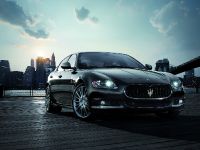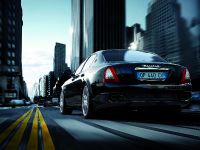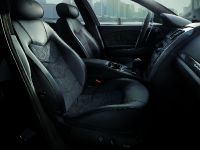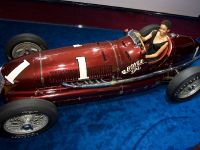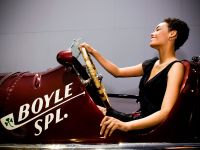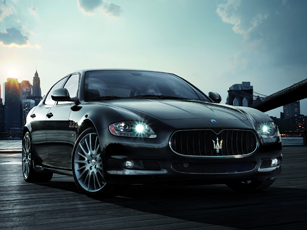Maserati Unveils New Quattroporte Sport GT S
The New Quattroporte Sport GT S Debuts in Detroit
The new Maserati Quattroporte Sport GT S making its worldwide première at the 2009 North American International Auto Show sets yet another milestone in terms of sportiness in the high performance luxury sedan segment of the automotive market. Conceived and developed as "a real driving machine in the guise of a luxury sedan", the Quattroporte Sport GT S is the ultimate expression of Maserati's sportiness in the Quattroporte range.
The technical changes to the new Quattroporte Sport GT S concern four areas:
• the mapping of the V8 4.7 litre engine, with power increased to 323kW; • the gearshift management software, with new features designed to increase driving enjoyment; • the front and rear suspension system featuring single-rate dampers, stiffer springs and lower ride height; • the sport exhaust controlled by pneumatic valves for a deep, throaty and captivating sound.
The sportier and more aggressive look is evident in the interior's and exterior's stylistic choices:
• the new black grille with concave vertical fins featuring the Trident logo with red accents, typical of the sportier versions of Maserati models; • the new headlights, in metallic titanium finish; • the new M-design seats with perforated Alcantara® and leather upholstery; • the standard trim in Titantex, a "titanium coloured" composite material.
Maserati Racing Legacy
In 1939 and 1940, long before any foreign brands were established in the United States, Maserati took the chequered flag at perhaps the world's most famous race, the Indianapolis 500. That car was a Modena-made 8CTF single-seater bearing the flamboyant name of "Boyle Special", driven by Wilbur Shaw. Today, to mark the 70th anniversary of Maserati's first win at Indianapolis, the Boyle Special is on display at Maserati's exhibit at the 2009 NAIAS as a direct link to the newest and sportiest of its products: the new Quattroporte Sport GT S.
The racetrack is where the name Maserati first became enduring and where we today continue to draw our central philosophy: a well balanced car capable of great feedback to the driver. The racetrack also continues to be the stage where Maserati collects international trophies in steady succession – with both Drivers' and Teams' FIA GT titles clinched in 2008 by Maserati's MC12 to make 10 the total of FIA international titles the Maserati V12 GT car has collected over the last four racing seasons, primarily courtesy of drivers Andrea Bertolini and Michael Bartels (champions in 2006 and 2008) and of the Vitaphone Racing Team (four consecutive titles from 2005 through 2008).
In the course of the 2008 racing season Maserati clinched the third win in four years at the legendary 24-Hours of Spa race, placing three MC12s in the first four positions of the final standing. The triumph in Belgium is the ultimate evidence of Maserati's reliability that originates on the racetrack but translates into the quality and consistency of Maserati's entire product range.
The 10 international trophies collected in the FIA GT championship since 2005 at the wheel of a Maserati MC12 are:
• 2 Manufacturers' Cup in 2005 and 2007; • 3 Drivers' titles (Bertolini-Bartels in 2006, Thomas Biagi in 2007, Bertolini-Bartels in 2008); • 4 Teams' titles (since 2005 with no interruption, always with the Vitaphone Racing Team); • 1 Citation Cup in 2007 with the gentleman driver Ben Aucott.
MC Sport Line Customisation Programme
Focusing on its racing vocation and fresh from its latest international triumph in the FIA GT championship, Maserati has developed a special series of new options named "MC Sport Line", which made its worldwide debut at the Bologna Motor Show in Italy in early December. The new contents of the MC Sport Line add to Maserati's already extensive range of personalised features on offer. The MC Sport Line is designed to enhance the sporty DNA of Maserati vehicles for those customers who like to display their passion for racing through a dynamic look and a choice of technical solutions that increase the driving fun without compromise.
The name "MC Sport Line" sums up the experience acquired on the track by the Maserati Corse department, whose contribution to the design of the functional components has been invaluable. The world of motor racing also inspired Maserati's designers when it came to styling, hence the extensive use of carbon fibre, very popular among racing enthusiasts thanks to its direct connection with racing competitions.
Maserati and the Environment
Maserati has implemented a development plan for the next 5 years designed to reduce consumption and CO2 emissions, and to protect the environment.
The designs of recent models have already led to considerable fuel savings. From 2005 onwards, consumption for the Quattroporte has been reduced by more than 20% overall (NEDC combined cycle). The CO2 reduction compared to the previous Gran Sport model is 10% for the GranTurismo S (NEDC extra-urban cycle).
On the new Quattroporte S with its 4.7 engine, exhaust/evap emissions and fuel consumption have been aligned with future Euro 5 regulations for Europe and LEV2 standards for the USA, partly thanks to the adoption of an innovative metallic matrix catalyser with perforated sheets (Turbulent PE Catalyst), which is both permeable and reliable but does not affect performance. The use of this solution has evened out the distribution of pollutant particles, reduced pressure, improved resistance to high temperatures and the transfer of gases.
Maserati also uses environmentally-friendly, easily recyclable materials made from natural substances, especially for the parts of the interior, which are most in contact with the driver and passengers (natural textile fibres, wood and leather).
Maserati cars are mindful of the "design for recycling" concept, which is centred around making cars easy to dismantle at the end of their working lives, so that materials can be identified and separated for re-use.
2008 Facts and Figures
By all degrees, Maserati's 2008 was the most successful year to date.
In the course of the year, a new product range was introduced – the new Quattroporte line-up with both 4.2 litre and 4.7 litre models. And new to the market was also a new engine solution for the GranTurismo model-line, thus enriched in 2008 by the arrival of the 4.7 litre GranTurismo S.
Despite the dreadful economic situation witnessed by all sectors of the world economy and the profound situation of crisis that has pervaded the automotive market from the beginning of the year, Maserati has achieved in 2008 the second record year in a row. Deliveries to the final customers have totalled almost 8,600 units, which is the all-time best result, with an increase of almost 17% over 2007. What is more, Maserati's sales were up in all markets across the world – including the United States of America.
Despite the troubled times experienced by the US economy, North America (US and Canada) remains Maserati's largest market worldwide. The order in which the other markets follow is both familiar and consolidated, as to state that, despite all the hardships, Maserati's presence in these markets is an established one: Italy is in second place, the United Kingdom in third, Germany in fourth, Japan in fifth. Five markets, three continents for a truly global Maserati presence. In sixth place there is France, followed by Switzerland, China, Australia, UAE, Hong Kong.
In the first nine months, Maserati's revenues amounted to €596 million, up 22.9% compared to the same period of the previous year. There was a 25% increase in deliveries to the network compared to the first 9 months of 2007, and this performance is even more significant considering that the target markets for Maserati vehicles shrank by about 15%.
In the first nine months of 2008, the result of ordinary activities was €31 million, with a 5.2% ratio to income – a significant increase on the €6 million (1.2% of revenues) achieved during the same period last year.
